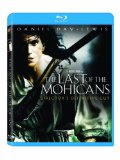| Reviews & Columns |
|
Reviews DVD TV on DVD Blu-ray 4K UHD International DVDs In Theaters Reviews by Studio Video Games Features Collector Series DVDs Easter Egg Database Interviews DVD Talk Radio Feature Articles Columns Anime Talk DVD Savant Horror DVDs The M.O.D. Squad Art House HD Talk Silent DVD
|
DVD Talk Forum |
|
|
| Resources |
|
DVD Price Search Customer Service #'s RCE Info Links |
|
Columns
|
|
|
Last of the Mohicans: Director's Definitive Cut, The
Fox // R // October 5, 2010
List Price: $34.99 [Buy now and save at Amazon]
The Film:
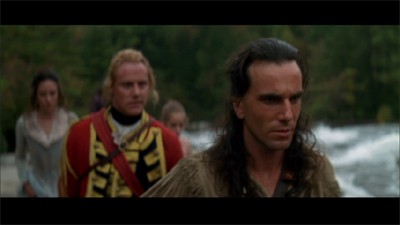 Vaulting off measured off-and-on cinematic successes with Manhunter and L.A. Takedown, Michael Mann skids off the urban thriller path for The Last of the Mohicans, a mixed adaptation of James Fenimore Cooper's novel and the original '36 motion picture. The story plays like a biopic, capturing the mid-1700s conflict between the British, French, and varied Indian tribes of the land, all surrounding the reverse-Pocahontas passion that strikes between Cora Munro (Madeline Stowe), daughter to a British commander, and "Hawkeye" Nathaniel (Daniel Day-Lewis), an adopted white son to the dying Mohican tribe. Though their relationship becomes the central thrust, Micheal Mann's convincing, moving historical blockbuster dodges any hint of maudlin romance with its trappings -- while, in the process, becoming the gritty crime-drama director's most atypical creation.
Vaulting off measured off-and-on cinematic successes with Manhunter and L.A. Takedown, Michael Mann skids off the urban thriller path for The Last of the Mohicans, a mixed adaptation of James Fenimore Cooper's novel and the original '36 motion picture. The story plays like a biopic, capturing the mid-1700s conflict between the British, French, and varied Indian tribes of the land, all surrounding the reverse-Pocahontas passion that strikes between Cora Munro (Madeline Stowe), daughter to a British commander, and "Hawkeye" Nathaniel (Daniel Day-Lewis), an adopted white son to the dying Mohican tribe. Though their relationship becomes the central thrust, Micheal Mann's convincing, moving historical blockbuster dodges any hint of maudlin romance with its trappings -- while, in the process, becoming the gritty crime-drama director's most atypical creation.
Set specifically during 1757 in the Glens Falls region of New York, though actually shot at era-appropriate forested areas around North Carolina's assorted falls and Asheville's Biltmore Estate, The Last of the Mohicans circles around a boiling point for several conflicts simmering during the period. It's a time when the British are recruiting for their army during the French and Indian War, a conscription that has many men reluctant to leave their families -- while also putting English-born Nathaniel in a meagerly-complex moral position. Underneath the stirring warfare, which will come to a head at the battle of Fort William Henry, the focus also centers on the cloak-and-dagger relations involving the two warring side and a Huron chieftain, Magua (Wes Studi), who holds disdain for a British commander. It's a justified anger, seeing as how his family was victim to the British war machine, a festering internal driver that establishes the film's harsh tones about conquest, assimilation, and perseverance of one's kind.
Like all of Mann's films, The Last of the Mohicans latches onto meticulous, method-based details to authenticate the experience as much as possible; as an admirer of George Seitz film and of the time period's strife, he and co-writer Christopher Crowe dive head-on into the actual fabric of this riff on history in an attempt to balance the action involving muskets in-hand with a vein of gripping storytelling. Down to the stitches of clothing on the actors' backs and the "Kentucky" rifles and melee weapons used, he achieves a stark tangibility with its aesthetics that transplants us to the 1700s. With that authenticity as a catalyst, Mann harnesses an elegant movement through the early American forests as he captures their treks through the wilderness, becoming one of the big draws to the film as the family of Mohicans effortlessly leap across fallen trees and blend into the environment.
Though Mann's persistent directorial precision claims the brunt of the accolades for this, this gracefulness wouldn't be as fluid without cinematographer Dante Spinotti's eye as he captures the sensations coursing through Nathaniel and his brethren while they sprint across the frontier. Spinotti's photography also achieves some rather involving battle sequences, both hand-to-hand between the Native Americans and in the midst of canon-driven warfare around Fort William Henry. His visual talent can be seen throughout, but it becomes especially potent in a fast-paced, tense canoe escape down-river late in the film that's superb. What Mann and Spinotti create is a seamless flow of intuitive, primal energy that breathes with the air of the period, breath-snatching on a fundamental level but never without a flicker of era-bound resonance.
Somehow, a love story -- built on an instinctual bond between Nathaniel and Cora's limited time together, stunted by the courting advances of British officer Duncan -- forms within these conflicts in The Last of the Mohicans, which relies on subtle storytelling and fine acting to accentuate the direness surrounding their blossoming love. Daniel Day-Lewis, who spent months in the wilderness before shooting in an act of method preparation, brings Nathaniel to life through his thick accent and deep, penetrating glances, fervently communicating the balance he's struck between his native lifestyle and his English roots. Madeline Stowe plays off of his intense glances well as staunchly independent Cora, while the other Munro sister, played by Jodhi May, offers a captivating innocence about her that'll become an integral element in one the film's most poignant moments.
As well as the protagonists are realized, including Eric Schweig as Nathaniel's Mohican brother Uncas and the commanding presence of legendary Indian activist Russell Means as Chingachgook, it's impossible to turn one's attention away from Wes Studi as Magua. Mann's casting for the film's villain couldn't have been more perfect; Studi holds an impeccable ability to balance both stoicism and unbridled energy in his glances, which only intensifies as his rumbling, graceful voice chops through both English, French, and Indian languages. Oddly, as exceptionally as both the story and Mann's direction demonize him, his place in the story -- as a man born of the land who's had his family taken from his by the alien forces -- becomes the nitty-gritty crux to the story's anti-conquest themes. He's evil in his process, and we know that, but it's hard not to feel shards of sympathy for him, which is the sign of a great villain.
Though the romance and war-bound theatrics remain captivating throughout, The Last of the Mohicans really becomes all about its volatile final act, a boiling point for both Magua's people and, obviously, the Mohicans. With the Irish-infused ballad "The Gael" pulsating in the backdrop, harder and more evocatively than it has throughout the rest of the picture, Mann orchestrates a brisk and powerful resolution to the film's consequences that, after repeated screenings, carries just as much emotionally-involving weight as when I watched it the first time. It brings together everything that hallmarks the film's construction -- Wes Studi's rigorous villainy, gorgeous location shots in the mountains, the conflicted perception of warring Indian tribes and the film's perpetual, often fierce movement -- and thrusts them forward into what's ultimately a bittersweet end to this sweeping story, yet rewarding and really quite flawless in the fabric it weaves.
Director's Definitive Edition:
For the home video market, The Last of the Mohicans has sprinted along at several differently-edited paces under Micheal Mann's repeated adding and subtracting -- though, mostly, the film really hasn't drastically changed shape from a storytelling standpoint since its theatrical run. For the Director's Expanded Edition, he beefed up the story with a few exposition-heavy blurbs and embellished shots throughout, taking the runtime to 1:56:42. Mann has once again gone under the hood to tinker with its flow for a "definitive cut" exclusively available on this Blu-ray, but he's gone in the other direction by chopping off nearly two minutes from the runtime to 1:54:33. Having watched both cuts simultaneously, wholly ready to annotate the differences and what-not, it's not unreasonable to state that the alterations aren't significant enough to change one's perception of the film very much. It's the same picture, compacted a bit and carrying a few new -- and obviously losing a few -- bells and whistles.
A few perceptible differences are worth mentioning. For one, Mann has tightened and rearranged the editing and, for several shots, elected towards alternate camera angles. Though the scene's audio will play out either the exact same or similarly, the camera will instead focus on a close-up or, as is the case more often than not, pulling away for a lengthier, fluid capturing of the scene without any breaks. Watch the conversation between Duncan and his commanding officer early on, as well as the banter between Magua and French General Montcalm. One scene also sees a change in the arrangement of dialogue: the conversation between Nathaniel and the Huron leader near the core dramatic twist in the conclusion. The content seems the same, but the placement of the Huron leader's poetic speech has been moved forward in the conversation, while a few alternate camera angles -- including one focused shot of Nathaniel that features an awkward split-second fast-forward motion -- have been employed.
Scenes shortened/trimmed: Battle outside Fort William Henry (left); Chingachgook's speech (right).
In regards to cuts and additions, a bulk of the battle around Fort William Henry has been excised, primarily the ground combat between the Duncan-led Brits and the French that whittles down roughly a minute from the runtime -- not the scenes involving the larger cannons, mind you, but the ground battle that, admittedly, might feel a bit clunky as it bloats around the fleeing/sniper scene where Nathaniel aids in the British soldiers' escape. Though, unfortunately, it's obvious that hard work and coordination went into orchestrating this burst of warfare, so it might be a sour change for some audiences. Aside from those key differences, along with the removal of an exposition-heavy chunk of Chingachgook's speech about frontier life at the very end of the film, the rest of the additions and subtractions (a few brief lines of dialogue here, condensing of a lesser atmosphere shot there) are minuscule and hardly alter the film's thrust.
Finally, in a welcome change that I'm assuming has to do with musical rights, Clannad's beautiful song "I Will Find You" has been reinserted into a pivotal scene that, for the Expanded Edition, had been removed from the score in lieu of a slower-paced version of "The Gael". Since it's really the only portion of The Last of the Mohicans that doesn't hinge on the rhythm of the tribal Irish-infused scoring, it places heartier emphasis on its place in the picture -- even if the lyrics (for the originally-performed piece) and song construction are a little less abstract than Mann's used to. Put simply, it's great to have the song added into the mix, one that most that haven't seen the theatrical cut will not have ever seen paired with the film. Note: thanks to a reader, it's worth noting that the recording of "I Will Find You" is in another language for the Blu-ray, though the melody itself remains the same.
The Blu-ray:
Fox Home Video have brought The Last of the Mohicans to Blu-ray in a standard eco-friendly case with an oddly-colored, uber-stylish artistic rendering of Daniel Day-Lewis on the cover. Note that this Blu-ray only contains Micheal Mann's Definitive Cut of the film, leaving off both the Expanded Cut and the Theatrical Cut.
Video and Audio:
The Last of the Mohicans arrives from Fox in a 2.35:1 1080p AVC encode, and it's one that's a little difficult to talk about. In comparison to the DTS "Director's Expanded Edition" DVD from a few years ago, there are a few key differences. One, the high-definition palette looks far, far more natural than the incredibly pink-leaning coloring that it exhibited, rendering lush terra-cotta skin tones less sun-baked elements. The disc's capacity to render shades of green can truly spellbound in several scenes, revealing lush vegetation that shifts tonality with the time of day during the shots. Elements like the gold leaf fabric on the British uniforms and the armband on Magua's tricep showcase elegant handling of metallic tones, while rushing water an expansive horizons test the boundaries of crisp, deep blues. Daytime sequences look exceptional more often than not, though a tad dark, while the disc supports the rapid movement of the characters with nary a block or digital blip to be seen.
But then, on the other side of the coin, there are nighttime scenes. Roughly half of the film takes place either around or close to the British stronghold during the night, as well as a few other scattered sequences -- notably the potent waterfall scene with Nathaniel and Cora. These exhibit detail-swallowing levels of darkness, often clouding contours in facial close-ups and location shots. This contrasts to the previous DVD, which suffered from some boosting in order to bring out these elements -- like Day-Lewis' face mid-conversation during his nighttime talk with Cora, or the conversation between Magua and Montcalm on the river bank -- that looked somewhat artificial. Somewhere in between the two lies a correct contrast level that agrees with artistic intent, but here it's unfortunately fairly distracting within this presentation. Essentially, this boils down to a decent-but-flawed high-definition treatment from Fox that makes up for its grievances with a few striking daytime sequences, including the entirety of the full-throttle conclusion in the mountains at its close.
The DTS HD Master Audio track also has its share of both exceptional and moderate moments, ultimately sounding extremely good with a few caveats. The musical scoring, a mix of Trevor Jones and Randy Edelman's work that hits hard with percussion and stringed instruments, sounds exceptional through the surrounding tracks, hitting crescendos and decrescendos with plenty of might in both the higher- and lower-end spectrums. Sounds effects like the rat-a-tat-tat of drums and the explosive punch from rifles and large cannons rattle the stage, hitting punchy mid-range points and exhibiting a level of grace in the afterthought ambient effects that impress. Rushing waterfalls sound especially rich, as they flood the expanses of the surround stage. It's in a few other assorted sound effects and verbal clarity that the track suffers a bit, especially with low-lying dialogue, where the somewhat monotone balance renders them a little difficult to hear. As mentioned earlier, it's a very good track, just with a few hiccups in the rudimentary point where it needs tightening. An English 2.0 track is also available, along with English SDH, Spanish, and French subtitles.
Special Features:
Commentary with director Micheal Mann:
If one were to sum up Micheal Mann's process of filmmaking in just a few words, they'd likely be knowledgeable, demanding, and painstaking. Mann doesn't exactly label himself as these things in his commentary, but the amount of historical context and cinematic construction factoids he spits out truly reflect on his style. He discusses where specific shots were obtained for the film, such as the bridge on Biltmore Estate, along with creating Day-Lewis into an enduring hero and Wes Studi into a strong villain. He talks about his affection for the original '36 film, as well as how cinematographer Dante Spinotti obtained exceptional lighting against riverbanks and amid roaring fires in the fort. Mann only hits a handful lengthy gaps where he doesn't reveal much about the content and veers off into somewhat obvious character explanations, coming together in what's otherwise an informative and engaging track.
Making of The Last of the Mohicans (42:43, HD AVC):
To supplement the commentary, a brand-new arrangement of interviews with cast/crew and some spectacular HD behind-the-scenes shots takes us through the construction of the film in a standard-yet-effective fashion. The material is separated into three chapters, each labeled acts, which click through their assorted points in a decently-organized fashion. It works best as a whole experience though, sitting through each one interconnected after another.
In Act I, Micheal Mann elaborates on his feelings on the "cartoon"-like nature of Cooper's original novel and his fascination with the volatile political strife present in the summer of 1757, while Daniel Day-Lewis discusses eating vast amounts of food and training with advisor Col. Webster for the survivalist background that Nathaniel needed as a character. In a really neat inclusion, this has also been accompanied by the rough, tape-shot training footage from his time on the Alabama course, and it's a lot of fun to see Day-Lewis acclimating to the physicality of the role. Mann shifts into how he concentrated on the love story between Nathaniel and Cora and how he achieved the right atmosphere around it in Act II of the piece, including obtaining Russell Means and Dennis Banks because of Mann's appreciation for their stand at Wounded Knee and the way Wes Studi played Magua. Act III covers the military-like construction of Fort William Henry, both the soldiers and the actual fort itself, which naturally leads into discussion about the authenticity of the props and set design. Mann talks about his experience with the Smithsonian and how he wanted to get the individual tribe aesthetics right.
Bringing up the rear of the supplements are a set of mediocre standard-definition Trailers, one teaser and one theatrical.
Final Thoughts:
Micheal Mann's The Last of the Mohicans endures as one of the '90s true successes in grand-scaled costume action, a deviation in style and substance for a director that mostly gravitates towards the grit of stylish, character-driven crime drama. Though it's a different flavor, Mann's film-making precision certainly shows in the production work, the rhythmic musical arrangements, and the orchestration of quite a few breathtaking action sequences, revealing why he was assuredly the right man for the job. All of that rides in a current along with self-aware, nimble storytelling that incorporates a vein of romance into the mixture, culminating into a period action-drama that moves with a fluid level of electricity towards its awe-inspiring conclusion. Fox's Blu-ray presentation of Mann's "Definitive Cut" might not be as awe-inspiring, sporting an overly dark but sustainable visual treatment and only a commentary and a making-of piece for substantive extras, but the film's quality in itself and the successes that this disc achieves still earn it a Recommendation.
Note: Screenshots in this review are from Fox's standard-definition release, and do not represent the quality of the disc reviewed here.
Thomas Spurlin, Staff Reviewer -- DVDTalk Reviews | Personal Blog/Site
 Vaulting off measured off-and-on cinematic successes with Manhunter and L.A. Takedown, Michael Mann skids off the urban thriller path for The Last of the Mohicans, a mixed adaptation of James Fenimore Cooper's novel and the original '36 motion picture. The story plays like a biopic, capturing the mid-1700s conflict between the British, French, and varied Indian tribes of the land, all surrounding the reverse-Pocahontas passion that strikes between Cora Munro (Madeline Stowe), daughter to a British commander, and "Hawkeye" Nathaniel (Daniel Day-Lewis), an adopted white son to the dying Mohican tribe. Though their relationship becomes the central thrust, Micheal Mann's convincing, moving historical blockbuster dodges any hint of maudlin romance with its trappings -- while, in the process, becoming the gritty crime-drama director's most atypical creation.
Vaulting off measured off-and-on cinematic successes with Manhunter and L.A. Takedown, Michael Mann skids off the urban thriller path for The Last of the Mohicans, a mixed adaptation of James Fenimore Cooper's novel and the original '36 motion picture. The story plays like a biopic, capturing the mid-1700s conflict between the British, French, and varied Indian tribes of the land, all surrounding the reverse-Pocahontas passion that strikes between Cora Munro (Madeline Stowe), daughter to a British commander, and "Hawkeye" Nathaniel (Daniel Day-Lewis), an adopted white son to the dying Mohican tribe. Though their relationship becomes the central thrust, Micheal Mann's convincing, moving historical blockbuster dodges any hint of maudlin romance with its trappings -- while, in the process, becoming the gritty crime-drama director's most atypical creation. Set specifically during 1757 in the Glens Falls region of New York, though actually shot at era-appropriate forested areas around North Carolina's assorted falls and Asheville's Biltmore Estate, The Last of the Mohicans circles around a boiling point for several conflicts simmering during the period. It's a time when the British are recruiting for their army during the French and Indian War, a conscription that has many men reluctant to leave their families -- while also putting English-born Nathaniel in a meagerly-complex moral position. Underneath the stirring warfare, which will come to a head at the battle of Fort William Henry, the focus also centers on the cloak-and-dagger relations involving the two warring side and a Huron chieftain, Magua (Wes Studi), who holds disdain for a British commander. It's a justified anger, seeing as how his family was victim to the British war machine, a festering internal driver that establishes the film's harsh tones about conquest, assimilation, and perseverance of one's kind.
Like all of Mann's films, The Last of the Mohicans latches onto meticulous, method-based details to authenticate the experience as much as possible; as an admirer of George Seitz film and of the time period's strife, he and co-writer Christopher Crowe dive head-on into the actual fabric of this riff on history in an attempt to balance the action involving muskets in-hand with a vein of gripping storytelling. Down to the stitches of clothing on the actors' backs and the "Kentucky" rifles and melee weapons used, he achieves a stark tangibility with its aesthetics that transplants us to the 1700s. With that authenticity as a catalyst, Mann harnesses an elegant movement through the early American forests as he captures their treks through the wilderness, becoming one of the big draws to the film as the family of Mohicans effortlessly leap across fallen trees and blend into the environment.
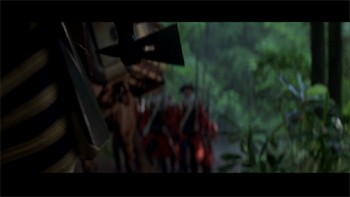 | 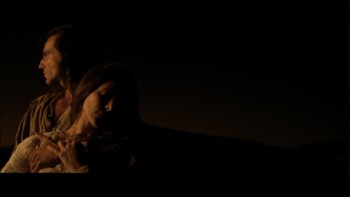 |
Though Mann's persistent directorial precision claims the brunt of the accolades for this, this gracefulness wouldn't be as fluid without cinematographer Dante Spinotti's eye as he captures the sensations coursing through Nathaniel and his brethren while they sprint across the frontier. Spinotti's photography also achieves some rather involving battle sequences, both hand-to-hand between the Native Americans and in the midst of canon-driven warfare around Fort William Henry. His visual talent can be seen throughout, but it becomes especially potent in a fast-paced, tense canoe escape down-river late in the film that's superb. What Mann and Spinotti create is a seamless flow of intuitive, primal energy that breathes with the air of the period, breath-snatching on a fundamental level but never without a flicker of era-bound resonance.
Somehow, a love story -- built on an instinctual bond between Nathaniel and Cora's limited time together, stunted by the courting advances of British officer Duncan -- forms within these conflicts in The Last of the Mohicans, which relies on subtle storytelling and fine acting to accentuate the direness surrounding their blossoming love. Daniel Day-Lewis, who spent months in the wilderness before shooting in an act of method preparation, brings Nathaniel to life through his thick accent and deep, penetrating glances, fervently communicating the balance he's struck between his native lifestyle and his English roots. Madeline Stowe plays off of his intense glances well as staunchly independent Cora, while the other Munro sister, played by Jodhi May, offers a captivating innocence about her that'll become an integral element in one the film's most poignant moments.
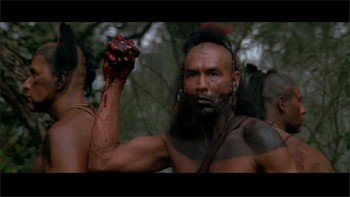 | 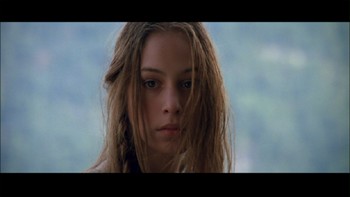 |
As well as the protagonists are realized, including Eric Schweig as Nathaniel's Mohican brother Uncas and the commanding presence of legendary Indian activist Russell Means as Chingachgook, it's impossible to turn one's attention away from Wes Studi as Magua. Mann's casting for the film's villain couldn't have been more perfect; Studi holds an impeccable ability to balance both stoicism and unbridled energy in his glances, which only intensifies as his rumbling, graceful voice chops through both English, French, and Indian languages. Oddly, as exceptionally as both the story and Mann's direction demonize him, his place in the story -- as a man born of the land who's had his family taken from his by the alien forces -- becomes the nitty-gritty crux to the story's anti-conquest themes. He's evil in his process, and we know that, but it's hard not to feel shards of sympathy for him, which is the sign of a great villain.
Though the romance and war-bound theatrics remain captivating throughout, The Last of the Mohicans really becomes all about its volatile final act, a boiling point for both Magua's people and, obviously, the Mohicans. With the Irish-infused ballad "The Gael" pulsating in the backdrop, harder and more evocatively than it has throughout the rest of the picture, Mann orchestrates a brisk and powerful resolution to the film's consequences that, after repeated screenings, carries just as much emotionally-involving weight as when I watched it the first time. It brings together everything that hallmarks the film's construction -- Wes Studi's rigorous villainy, gorgeous location shots in the mountains, the conflicted perception of warring Indian tribes and the film's perpetual, often fierce movement -- and thrusts them forward into what's ultimately a bittersweet end to this sweeping story, yet rewarding and really quite flawless in the fabric it weaves.
Director's Definitive Edition:
For the home video market, The Last of the Mohicans has sprinted along at several differently-edited paces under Micheal Mann's repeated adding and subtracting -- though, mostly, the film really hasn't drastically changed shape from a storytelling standpoint since its theatrical run. For the Director's Expanded Edition, he beefed up the story with a few exposition-heavy blurbs and embellished shots throughout, taking the runtime to 1:56:42. Mann has once again gone under the hood to tinker with its flow for a "definitive cut" exclusively available on this Blu-ray, but he's gone in the other direction by chopping off nearly two minutes from the runtime to 1:54:33. Having watched both cuts simultaneously, wholly ready to annotate the differences and what-not, it's not unreasonable to state that the alterations aren't significant enough to change one's perception of the film very much. It's the same picture, compacted a bit and carrying a few new -- and obviously losing a few -- bells and whistles.
A few perceptible differences are worth mentioning. For one, Mann has tightened and rearranged the editing and, for several shots, elected towards alternate camera angles. Though the scene's audio will play out either the exact same or similarly, the camera will instead focus on a close-up or, as is the case more often than not, pulling away for a lengthier, fluid capturing of the scene without any breaks. Watch the conversation between Duncan and his commanding officer early on, as well as the banter between Magua and French General Montcalm. One scene also sees a change in the arrangement of dialogue: the conversation between Nathaniel and the Huron leader near the core dramatic twist in the conclusion. The content seems the same, but the placement of the Huron leader's poetic speech has been moved forward in the conversation, while a few alternate camera angles -- including one focused shot of Nathaniel that features an awkward split-second fast-forward motion -- have been employed.
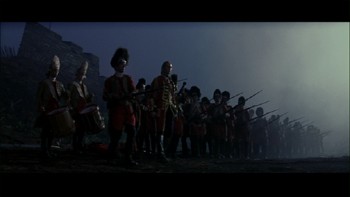 | 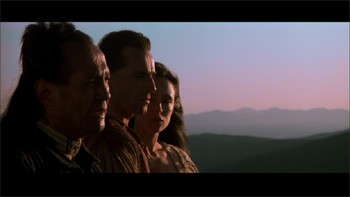 |
In regards to cuts and additions, a bulk of the battle around Fort William Henry has been excised, primarily the ground combat between the Duncan-led Brits and the French that whittles down roughly a minute from the runtime -- not the scenes involving the larger cannons, mind you, but the ground battle that, admittedly, might feel a bit clunky as it bloats around the fleeing/sniper scene where Nathaniel aids in the British soldiers' escape. Though, unfortunately, it's obvious that hard work and coordination went into orchestrating this burst of warfare, so it might be a sour change for some audiences. Aside from those key differences, along with the removal of an exposition-heavy chunk of Chingachgook's speech about frontier life at the very end of the film, the rest of the additions and subtractions (a few brief lines of dialogue here, condensing of a lesser atmosphere shot there) are minuscule and hardly alter the film's thrust.
Finally, in a welcome change that I'm assuming has to do with musical rights, Clannad's beautiful song "I Will Find You" has been reinserted into a pivotal scene that, for the Expanded Edition, had been removed from the score in lieu of a slower-paced version of "The Gael". Since it's really the only portion of The Last of the Mohicans that doesn't hinge on the rhythm of the tribal Irish-infused scoring, it places heartier emphasis on its place in the picture -- even if the lyrics (for the originally-performed piece) and song construction are a little less abstract than Mann's used to. Put simply, it's great to have the song added into the mix, one that most that haven't seen the theatrical cut will not have ever seen paired with the film. Note: thanks to a reader, it's worth noting that the recording of "I Will Find You" is in another language for the Blu-ray, though the melody itself remains the same.
The Blu-ray:
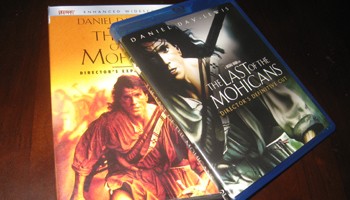 | 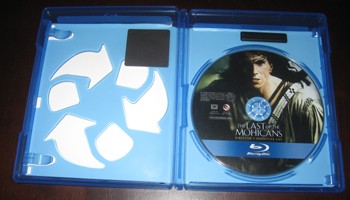 |
Fox Home Video have brought The Last of the Mohicans to Blu-ray in a standard eco-friendly case with an oddly-colored, uber-stylish artistic rendering of Daniel Day-Lewis on the cover. Note that this Blu-ray only contains Micheal Mann's Definitive Cut of the film, leaving off both the Expanded Cut and the Theatrical Cut.
Video and Audio:
The Last of the Mohicans arrives from Fox in a 2.35:1 1080p AVC encode, and it's one that's a little difficult to talk about. In comparison to the DTS "Director's Expanded Edition" DVD from a few years ago, there are a few key differences. One, the high-definition palette looks far, far more natural than the incredibly pink-leaning coloring that it exhibited, rendering lush terra-cotta skin tones less sun-baked elements. The disc's capacity to render shades of green can truly spellbound in several scenes, revealing lush vegetation that shifts tonality with the time of day during the shots. Elements like the gold leaf fabric on the British uniforms and the armband on Magua's tricep showcase elegant handling of metallic tones, while rushing water an expansive horizons test the boundaries of crisp, deep blues. Daytime sequences look exceptional more often than not, though a tad dark, while the disc supports the rapid movement of the characters with nary a block or digital blip to be seen.
But then, on the other side of the coin, there are nighttime scenes. Roughly half of the film takes place either around or close to the British stronghold during the night, as well as a few other scattered sequences -- notably the potent waterfall scene with Nathaniel and Cora. These exhibit detail-swallowing levels of darkness, often clouding contours in facial close-ups and location shots. This contrasts to the previous DVD, which suffered from some boosting in order to bring out these elements -- like Day-Lewis' face mid-conversation during his nighttime talk with Cora, or the conversation between Magua and Montcalm on the river bank -- that looked somewhat artificial. Somewhere in between the two lies a correct contrast level that agrees with artistic intent, but here it's unfortunately fairly distracting within this presentation. Essentially, this boils down to a decent-but-flawed high-definition treatment from Fox that makes up for its grievances with a few striking daytime sequences, including the entirety of the full-throttle conclusion in the mountains at its close.
The DTS HD Master Audio track also has its share of both exceptional and moderate moments, ultimately sounding extremely good with a few caveats. The musical scoring, a mix of Trevor Jones and Randy Edelman's work that hits hard with percussion and stringed instruments, sounds exceptional through the surrounding tracks, hitting crescendos and decrescendos with plenty of might in both the higher- and lower-end spectrums. Sounds effects like the rat-a-tat-tat of drums and the explosive punch from rifles and large cannons rattle the stage, hitting punchy mid-range points and exhibiting a level of grace in the afterthought ambient effects that impress. Rushing waterfalls sound especially rich, as they flood the expanses of the surround stage. It's in a few other assorted sound effects and verbal clarity that the track suffers a bit, especially with low-lying dialogue, where the somewhat monotone balance renders them a little difficult to hear. As mentioned earlier, it's a very good track, just with a few hiccups in the rudimentary point where it needs tightening. An English 2.0 track is also available, along with English SDH, Spanish, and French subtitles.
Special Features:
Commentary with director Micheal Mann:
If one were to sum up Micheal Mann's process of filmmaking in just a few words, they'd likely be knowledgeable, demanding, and painstaking. Mann doesn't exactly label himself as these things in his commentary, but the amount of historical context and cinematic construction factoids he spits out truly reflect on his style. He discusses where specific shots were obtained for the film, such as the bridge on Biltmore Estate, along with creating Day-Lewis into an enduring hero and Wes Studi into a strong villain. He talks about his affection for the original '36 film, as well as how cinematographer Dante Spinotti obtained exceptional lighting against riverbanks and amid roaring fires in the fort. Mann only hits a handful lengthy gaps where he doesn't reveal much about the content and veers off into somewhat obvious character explanations, coming together in what's otherwise an informative and engaging track.
Making of The Last of the Mohicans (42:43, HD AVC):
To supplement the commentary, a brand-new arrangement of interviews with cast/crew and some spectacular HD behind-the-scenes shots takes us through the construction of the film in a standard-yet-effective fashion. The material is separated into three chapters, each labeled acts, which click through their assorted points in a decently-organized fashion. It works best as a whole experience though, sitting through each one interconnected after another.
In Act I, Micheal Mann elaborates on his feelings on the "cartoon"-like nature of Cooper's original novel and his fascination with the volatile political strife present in the summer of 1757, while Daniel Day-Lewis discusses eating vast amounts of food and training with advisor Col. Webster for the survivalist background that Nathaniel needed as a character. In a really neat inclusion, this has also been accompanied by the rough, tape-shot training footage from his time on the Alabama course, and it's a lot of fun to see Day-Lewis acclimating to the physicality of the role. Mann shifts into how he concentrated on the love story between Nathaniel and Cora and how he achieved the right atmosphere around it in Act II of the piece, including obtaining Russell Means and Dennis Banks because of Mann's appreciation for their stand at Wounded Knee and the way Wes Studi played Magua. Act III covers the military-like construction of Fort William Henry, both the soldiers and the actual fort itself, which naturally leads into discussion about the authenticity of the props and set design. Mann talks about his experience with the Smithsonian and how he wanted to get the individual tribe aesthetics right.
Bringing up the rear of the supplements are a set of mediocre standard-definition Trailers, one teaser and one theatrical.
Final Thoughts:
Micheal Mann's The Last of the Mohicans endures as one of the '90s true successes in grand-scaled costume action, a deviation in style and substance for a director that mostly gravitates towards the grit of stylish, character-driven crime drama. Though it's a different flavor, Mann's film-making precision certainly shows in the production work, the rhythmic musical arrangements, and the orchestration of quite a few breathtaking action sequences, revealing why he was assuredly the right man for the job. All of that rides in a current along with self-aware, nimble storytelling that incorporates a vein of romance into the mixture, culminating into a period action-drama that moves with a fluid level of electricity towards its awe-inspiring conclusion. Fox's Blu-ray presentation of Mann's "Definitive Cut" might not be as awe-inspiring, sporting an overly dark but sustainable visual treatment and only a commentary and a making-of piece for substantive extras, but the film's quality in itself and the successes that this disc achieves still earn it a Recommendation.
Note: Screenshots in this review are from Fox's standard-definition release, and do not represent the quality of the disc reviewed here.
|
| Popular Reviews |
| Sponsored Links |
|
|
| Sponsored Links |
|
|
| Release List | Reviews | Shop | Newsletter | Forum | DVD Giveaways | Blu-Ray | Advertise |
|
Copyright 2024 DVDTalk.com All Rights Reserved. Legal Info, Privacy Policy, Terms of Use,
Manage Preferences,
Your Privacy Choices | |||||||









